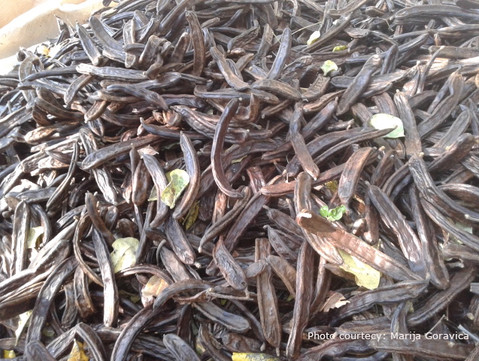The forgotten sweetness of carob
- Brina
- Jan 12, 2019
- 2 min read
Updated: Jan 4, 2021
If you have visited Šipan before, you may have quite often spotted old carob trees along the road. Usually they grow among olives, don't require any specific care, and so are relatively easy to cultivate.
In the past carob was used in cooking instead of sugar, and was regarded as a yummy and a quite expensive treat. Many residents of Šipan cultivated carob trees, and were considered wealthy people. It has been a tough job of picking and processing of the carob pods, but well repaid, and the product was sold in Croatia as well as abroad.
One of Vyeko's precious memories from the 1970's is of helping to transport raw carob pods from Šipan to the mainland, on a big boat that has been dangerously overloaded. The precious carob had to go, because there was a big demand for it.
From the 1970's the cheap cane sugar was widely introduced to the market in Croatia just like throughout the rest of Europe. It was cheaper for dealers to import cane sugar, and so the tasteful and healthy carob became forgotten.
But in recent times, when people are becoming more aware of the importance of a healthy lifestyle, our footprint on the environment and the many environmental and the moral issues related with industrial farming, it looks like finally the time has come for the precious carob to make an undoubtful return.
The first time I picked a ripe carob pod in August, about three years ago, and tasted it, mmmmm, I was surprised how the taste was so similar to chocolate! Nature is amazing, it created a healthy chocolate that can be picked from a tree and eaten. I loved it, and ever since started putting carob flour in most of my cakes and in Miho's favourite apple strudel.
Carob has many health benefits. It is high on fiber and contains no caffeine, so it is perfect for people with high blood pressure. On the other hand, carob is low on sugar and fat, which makes it the right substitute to chocolate for people who are trying to loose weight, and even for diabetics. The latest tests on Šipan's carob flour showed that it is naturally gluten free, and is rich on Kalium and Calcium.
In Croatia the highest quality of carob flour comes from the island of Vis and from Šipan island. There is a huge difference between the taste of the carob flour from the supermarkets, and the one produced by a small family company from Vis, and available in the DM drugstores in Croatia. I was sticking to the carob from Vis, but am now starting to use the one from Šipan.

Our close relative Mato Goravica truly believes in the sweet power of carob and is working on reviving its traditional cultivation on Šipan. His first line of packaged carob flour from Šipan will very soon be available on the market, and we are so proud and excited about it!




Carob was undeservedly forgotten, but for sure is making a spectacular return to our finest cake recipes!
Check out Mato's web site to learn more about his carob project on Šipan: www.goravica.com.
















Comments